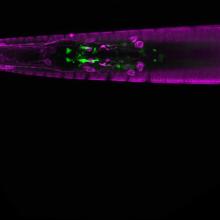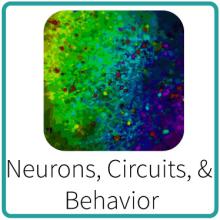Upcoming Events!
Past Events

In person or join via Zoom meeting|full_html
In person or join via Zoom meeting|full_html

<p>Abstract: Basal forebrain cholinergic neurons (BFCNs) project throughout the neocortex, hippocampus...</p>
<p>Abstract: Basal forebrain cholinergic neurons (BFCNs) project throughout the neocortex, hippocampus, and amygdala to regulate arousal, stimulus salience, plasticity, and learning. Our research has shown that cholinergic neurons in the extreme caudal tail of the basal forebrain are functionally distinct from more rostral areas. Whereas the activity of rostral BFCNs are closely related to global brain state, caudal tail BFCNs exhibit rapid, low-threshold phasic responses to a broad class of unconditioned auditory stimuli that rapidly reorganize to enhance the representation of threat-predicting sounds. I will describe how plasticity in caudal tail BFCNs can serve as a teaching signal to guide auditory cortex reorganization during associative learning. Finally, I will discuss the history of “hacking” BFCN activity through direct stimulation protocols to produce targeted forms of plasticity in the auditory cortex. I will describe our ongoing efforts to control the activity of caudal BFCNs and select types of cortical GABAergic interneurons to reduce auditory hypersensitivity, a defining phenotype in aging, sensorineural hearing loss, and several neurodevelopmental and neuropsychiatric disorders. </p>
<p><a href="https://scholar.harvard.edu/polleylab/home">Learn more</a></p>
|full_html


<p>Abstract:<br>
Brain-computer interfaces (BCI) translate neural activity into movements of a computer...</p>
<p>Abstract:<br>
Brain-computer interfaces (BCI) translate neural activity into movements of a computer cursor or robotic limb. BCIs are known for their ability to assist paralyzed patients. A lesser known, but increasingly important, use of BCIs is their ability to further our basic scientific understanding of brain function. In particular, BCIs are providing insights into the neural mechanisms underlying sensorimotor control that are currently difficult to obtain using limb movements. In this talk, I will demonstrate how a BCI can be leveraged to study how the brain learns. Specifically, I will address why learning some tasks is easier than others, as well as how populations of neurons change their activity in concert during learning.</p>
<p>Brief bio:<br aria-hidden="true">
Byron Yu received the B.S. degree in Electrical Engineering and Computer Sciences from the University of California, Berkeley in 2001. He received the M.S. and Ph.D. degrees in Electrical Engineering in 2003 and 2007, respectively, from Stanford University. From 2007 to 2009, he was a postdoctoral fellow jointly in Electrical Engineering and Neuroscience at Stanford University and at the Gatsby Computational Neuroscience Unit, University College London. He then joined the faculty of Carnegie Mellon University in 2010, where he is a Professor in Electrical & Computer Engineering and Biomedical Engineering and the Gerard G. Elia Career Development Professor. He is broadly interested in how large populations of neurons process information, from encoding sensory stimuli to driving motor actions. His group develops and applies novel statistical algorithms and uses brain-computer interfaces to study brain function.</p>
<p><a href="https://users.ece.cmu.edu/~byronyu/">Learn more</a></p>
|full_html


<p>Abstract: I will explore two core principles of circuit models for perceptual decisions. In these...</p>
<p>Abstract: I will explore two core principles of circuit models for perceptual decisions. In these models, neural ensembles that encode actions compete to form decisions. Consequently, representation and readout of the decision variables (DVs) in these models are implemented similarly for decisions with identical competing actions, irrespective of input and task context differences. Further, DVs are encoded as partially potentiated action plans through balance of activity of action-selective ensembles. I show that the firing rates of neurons in the posterior parietal cortex of monkeys performing motion and face discrimination tasks violate these principles. Instead, neural responses suggest a mechanism in which decisions form along curved population-response manifolds misaligned with action representations. These manifolds rotate in state space for different task contexts, making optimal readout of the DV task dependent. Similar manifolds exist in lateral and medial prefrontal cortex, suggesting common representational geometries across decision-making circuits. </p>
<p><a href="https://as.nyu.edu/faculty/roozbeh-kiani.html">Learn more</a></p>
|full_html

Join us for ION Happy Hour this Friday at 4 pm. Science, fresh air, locally brewed beverages, salty...
Join us for ION Happy Hour this Friday at 4 pm. Science, fresh air, locally brewed beverages, salty snacks, gluten free options, and you don't have to worry about turning your camera and microphone on or off.<br aria-hidden="true">
|full_html

<a href="https://urldefense.com/v3/__https://sites.wustl.edu/bagnall/__;!!C5qS4Y… more</a>|full_html
<a href="https://urldefense.com/v3/__https://sites.wustl.edu/bagnall/__;!!C5qS4Y… more</a>|full_html


stuff here
stuff here
